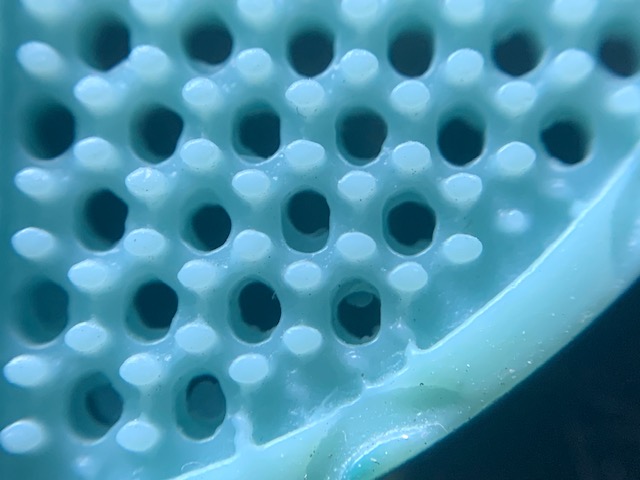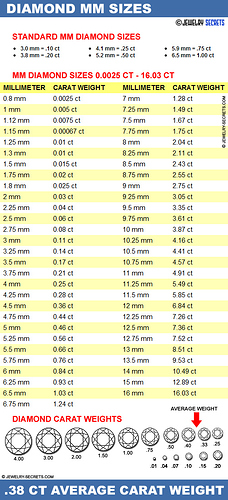Hello,
I am curious to know…what size diamond stones are “typically” used for pave, micro pave, and halo styles, please?
or, I guess a better question would be- what is “typically” the “smallest” size diamond stones used to comfortably set pave, micro pave, and halo styles…?
is .80mm too terribly small?
Julie
Hi Julie
For Pave setting I use nothing larger than .03 pointers. Anything larger is very tough to bead-set, trust me!
I have on some occasions, bead-set .005 pointers, but this is not the ‘normal’ size!
For 4-claw/prong (cluster tops)the range is from .02 - .10 max.
Channel Setting is best at the .05 - .10 point sizes.
I’m sure you will be getting other results but these are my views. Micro-pave is only the instrument to help you see better!
My vision is now 20/20 and I can see to bead-set 1/2 point diamonds. That is 4-beads to a stone…
Hope that this was a help to you. Regards, eh!
Gerry, on my iPhone
2 Likes
The other thing to consider is the cost of setting compared to the price you can charge for the piece. If you’re doing your own setting and you live in a Western country you won’t be able to get your labor back if you’re setting a bunch of ½pt or ¼pt stones. Unless you’ve got a quite large center stone on which you can pad the markup to cover the cost of setting all those little stones, doing micro-pavé is a loser.
In the old days, and Gerry will remember those, no one ever did that kind of micro-pavé, and no one paved the shank all the way round the back. Customers were not willing to pay for it. And then larger firms began to job out their setting to Thailand, and suddenly the setting costs were much lower. That’s when paving shanks all the way round, and making entourages of tiny stones became economically feasible.
So calculate not only the cost of the stones, but also the cost of the labor in relation to the stones. You want the cost of the stones to be a greater percentage of the price of the piece than the labor. That way the customer feels he is getting value for money. Outside the art jewelry market no one wants to pay for your labor, and being able to say that the majority of the price is in the stones is a strong selling point.
1 Like
Elliot & Julie
Another added note is that now came CAD designing. and guess what happened? No beads were created on the metal. Now all you see are a myriad of fine-looking & uniform mini-posts to circumvent the need to use your Onglette graver #1, or #2 to make each bead. Interesting to read these questions & answers as this is my next essay (still being edited) Here is a sample photograph of this kind of labour-saving process.

Hoping that the between Elliot and myself, you & everyone get to have a better understanding of how jewellery has progressed over the years/decades
Regards to you all.
Hi Gerry and Elliott!
thank you for your comments.
Gerry, are you mentioning diamonds in carat size on your reply?
meaning .05 pointer= .05 carat= 1.0 mm?
Julie
Hi Gerry,
what is millimeter size of .03 pointer?
julie
Not too sure, but G.I.A. has the diamond size charts on their website. Or you can just Google “diamond size @ .03 points” and a whole pile of charts will come up.
Gerry, on my iPhone
Hi Gerry and Elliott,
Very interesting! Learning about sizes today! I usually go by millimeters for everything…)
google is my friend!
I am usually in the 1.0-1.5mm range, but I am doing something that might be better with a few smaller stones at the tapered ends…so was curious “how small” should I go?..1/4 point/ 0.80mm is what I am thinking after this conversation…?
ok, so:
(if I am reading Gerry’s figures correctly, then these stones are smaller than a 1/4 point diamond…?)
005 point diamond= .005/ 100 of a carat= .00005 carat= ? mm
.02 point diamond= .02/100 of a carat= .0002 carat= ? mm
.03 point diamond= .03/100 of a carat= .0003 carat= ? mm
.05 point diamond= .05/100 of a carat= .0005 carat= ? mm
.10 point diamond= .10/100 of a carat= .0010 carat= ? mm
.25 point diamond= .25/100 of a carat= 0.0025 carat= .80mm
(1/4 point diamond= .25/100 of a carat= 0.0025 carat= .80mm)
.50 point diamond= .50/100 of a carat= 0.005 carat= 1.0mm
(1/2 point diamond= .50/100 of a carat= 0.005 carat= 1.0.mm)
.67 point diamond= .67/100 of a carat= 0.0067 carat= 1.12mm
.75 point diamond= .75/100 of a carat= 0.0075 carat= 1.15mm
1 point diamond= 1/100 of a carat= .01 carat= 1.25mm to 1.30mm
2 point diamond= 2/100 of a carat= .02 carat= 1.75mm
3 point diamond= 3/100 of a carat= .03 carat= 2.0mm
4 point diamond= 4/100 of a carat= .04 carat= 2.25mm
6 point diamond= 6/100 of a carat= .06 carat= 2.50mm
8 point diamond= 8/100 of a carat= .08 carat = 2.75mm
11 point diamond= 11/100 of a carat= .11 carat= 3.0mm
My Stuller stone catalogs go down to about +/- the 1/4 point/ .070mm 0.80mm range…
Julie
Elliot
You just helped me with something interesting that I’m now creating. This diamond scale is just “fantastic”. I suggest everyone who has been reading these posts print this out for themselves. I just did that and keeping it for my records!
If you’re only talking about a few very small stones in a narrow section or tapered point of a section you’ll not add too much labor. Although, if the piece is in yellow gold or platinum you can mimic a tiny stone or two by simply raising a few beads to fill that area. That will give sufficient sparkle without needing to set tiny stones.


